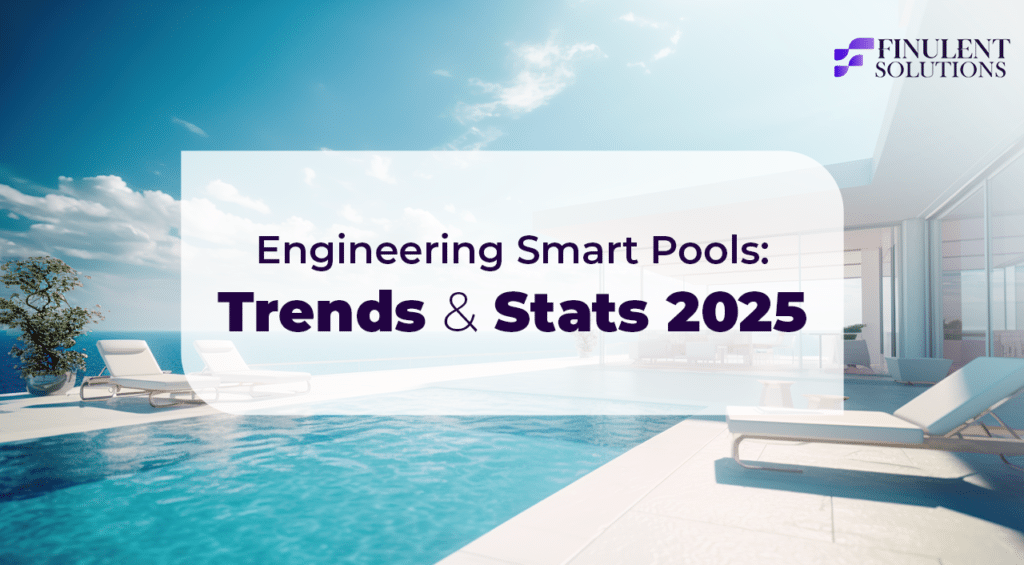The swimming pool sector is changing with the influence of new technology, sustainability, and consumer behaviours. Pool design today has moved away from aesthetics-only, now having more of a focus on technology such as smart hydraulics, ergonomics and wellness, building code compliance, off-site and modular technologies, and environmental features.
Industry Landscape and Market Growth
Key Pool Industry Statistics:
- Worldwide Pool Construction Market size: Valued at USD 6.77 billion in 2023, it is anticipated to grow to over USD 9.4 billion by 2030.
- Smart Pool Technology-market CAGR: 7.3% between 2024-2029
- Residential Pool Count (USA): 10.4 million+ private pools.
The accelerating demand for energy-efficient, safe, and modular pools is prompting unusually rapid change to both the design and construction process for pools from the initial thought to practical completion.
Smart Hydraulic Systems
An excellent hydraulic circulation system is a key factor in safe and energy-efficient pool dynamics. Waterco USA Inc. has introduced several technologies related to hydraulic engineering, as mentioned below:
Key Technologies:
- Hydrostorm ECO-V 150 Pump: variable speed motor, energy reductions of up to 70%, adheres to California Energy Commission (CEC) standards. A ground-breaking simulation of water movement also assists with optimal plumbing layout positioning.
- MultiCyclone Pre-Filter: removes up to 80% of sediment from the water before it enters the main filter, which results in lower backwashing and water wastage.
Hydraulic modelling systems are being applied to a greater degree (EPANET and Pipe Flow Expert) to help simulate hydraulic loads of the system and help determine the best positioning of a pump, filter or return jet assembly.
Chemical Dosing, Safety & Compliance
Due to rigorous public health guidelines, exacting chemical control has become an important element of pool design.
Experts like Allied Universal Corp provide:
- NSF-certified sodium hypochlorite (liquid chlorine).
- pH neutralisers and automatic chlorine injection systems.
- IoT-based dosing systems that allow online monitoring of water chemistry.
Engineering Considerations:
- Dosing rooms need to comply with NFPA 30, OSHA 1910.1200 and local health codes.
- Engineers should provide ventilation, bunding and emergency neutralisation zones in their technical drawings.
Designers now also routinely provide chemical room layouts and dosing schedules as a standard part of the broader design engineering deliverables.
Tile Technology and Slip Safety
Advancements in tile technology have improved both the look and functional safety of pool surfaces. Aquabella Tile offers pool options that balance safety, thermal comfort and durability.
Featured Products:
- R11 Anti-Slip Porcelain Tiles: An excellent choice for pool edges, steps and sun decks; porcelain with a high coefficient of friction (COF wet > 0.6) with limits on thermal expansion, UV resistance, chlorine and salts.
Design Integration:
Tile layout plan individual designs to explore accessible drain slope or thermal expansion joints, material thermal absorption and design with both purpose and aesthetics for maximum versatility.
Ergonomic and Wellness-Driven Design
Aquatica aligns biomechanics with spa design and offers products based on user-centred design theory and hydrotherapy efficacy.
Key Features:
- Ergonomic Shapes: Supports spinal alignment and offers comfort.
- Proprietary Materials: AquaStone is an example of a material that is thermally led and offers tactile comfort.
- Hydromassage Components: Hydro-massage goes beyond a jet fixture alone with air and water diffusion into the product for pain relief and muscle recovery as best it can.
These types of products are often specified in the Revit BIM families to facilitate hydraulic and electrical placement in spa zone layouts.
Modular Pool Innovation
The Little Pool Co. excels in durable prefabricated pools that are thermally insulated and compact. They are particularly useful for urban centres or rooftops.
System Highlights:
- Fibreglass-reinforced composite shells.
- Transportable by either crane lifting or truck.
- Thermally insulated to prevent heat loss up to 60%.
- Fully pre-plumbed with in-wall skimmers and pumps.
This trend promotes short installation periods, minimal excavations, and less site impact. Structural engineers typically use STAAD Pro or Tekla to evaluate point loads on roofs to see if a pool can be utilised.
Engineering-Driven Sustainability in Pool Design
Contemporary styles of pool design are focused on lifecycle impacts and operational sustainability.
Some of the more common “green features” include:
- Solar Pool Heaters – These systems provide an annual reduction in heating energy of between 20% and 40%.
- Rainwater Harvesting and Greywater Top-Up Systems.
- Energy-Efficient LED Lighting Systems.
- Smart Covers – These are designed to reduce evaporation losses by up to 50-70%.
Sustainability assessments employ tools like RETScreen, EnergyPlus, and LEED-compliance checklists to assess how environmentally friendly something really is.
Future-Ready Pool Design with Finulent Solutions
The future of pool design is now made possible with a combination of engineering precision, modularity, and sustainability. Finulent Solutions is an engineering design partner that incorporates global best practices from company leaders such as Waterco, Aquabella, Allied Universal, Aquatica, and The Little Pool Co. Each pool development is addressed using advanced integrated BIM, hydraulic modelling, structural detail, and code-compliant layouts. This ensures all finished pools are safe, efficient, luxurious and designed to be engineered for the future.

